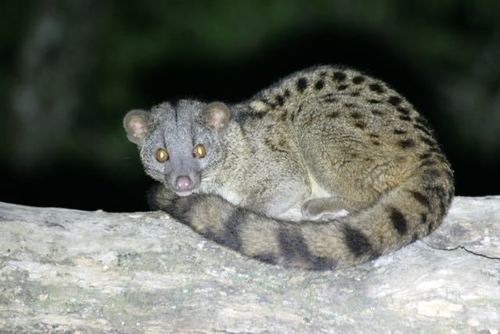
African Palm Civet
The elusive Nandinia binotata, or African palm civet, prowls the night in African rainforests. With its striking spotted fur and bushy tail, it deftly climbs trees in search of fruits and insects. This nocturnal creature plays a vital role in seed dispersal, enriching forest biodiversity.
15-20 years
Lifespan
1.4 - 4.5 kg
Weight
Height: 43 - 71 cm
Size
Brown, Grey, Yellow, Black, White, Tan
Color
2-3 years
Age of Sexual Maturity
2 months
Age of Weaning
Least Concern
Conservation Status
Unknown
Population Trend
Characteristics
Nandinia binotata, commonly known as the African palm civet, is a small, secretive mammal found in tropical forests across sub-Saharan Africa. It has a long body, short legs, a bushy tail, and spotted fur. Nocturnal by nature, it is an agile climber that feeds on fruits, insects, and small vertebrates.
Distribution Range of the African Palm Civet
Nandinia binotata, commonly known as the African palm civet, is native to sub-Saharan Africa. Its geographical distribution extends from the West African countries such as Senegal and Gambia, across Central Africa, including countries like Cameroon and the Democratic Republic of the Congo, to East Africa, reaching as far as Kenya and Tanzania. It is also found in parts of southern Africa, including Angola and Zambia.
African Palm Civet's Habitat
Environmental Conditions
The African palm civet inhabits a variety of environments, primarily favoring tropical and subtropical forests. It is often found in rainforests, both primary and secondary, as well as in woodland and savanna regions. The species is known to thrive in areas with dense vegetation that provide ample cover, such as thick underbrush and forested riverbanks. The climate in these regions is typically warm and humid, with significant rainfall.
Ecological Niche
Nandinia binotata is primarily nocturnal and arboreal, spending much of its time in trees. It is an omnivorous species, with a diet that includes fruits, small mammals, insects, and occasionally birds. Its role in the ecosystem includes seed dispersal due to its fruit consumption, and it acts as both predator and prey within its habitat. The species is adaptable and can live in proximity to human settlements, often utilizing agricultural areas and plantations.
Copyright @ Nature Style Limited. All Rights Reserved.
 English
English